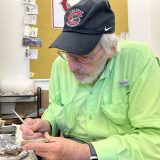The Numaserver Offers Big Opportunities For Computational and Data Sciences
August 14, 2015
For
Computational and Data Science
faculty and students, the recent acquisition of the Numaserver is important, but the advantages it provides are only just being tapped into. Installed at the end of May, 2015, the Numaserver is still in the experimental phase of its installation. Faculty members and students have just started using the device, and what they have seen thus far is promising.
But what is the Numaserver?
The Non-Uniform Memory Architecture (NUMA) server does exactly what most servers do, which is provide services to other computer programs – notably for Computational and Data Sciences, programs like SPARK and R. The specs alone are impressive enough to justify its existence; with 8 interconnected blades that each consist of 3 CPUs and 192 gigabytes of RAM, when combined as simply one single server it can process with 384 cores and just over 1.5 TERABYTES of RAM. Bottom line: This is a much more powerful system than what Schmid College has had previously.
This amount of memory and speed will permit both data-intensive and computer intensive applications to run much faster – particularly SPARK, a newer system which will make a transition from running on disk processing to running on memory processing. Memory processing is much faster than disk processing, which is where the new Numaserver will help enormously.

Dr. Michael Fahy, Associate Dean of Schmid College of Science and Technology, poses with the brand new Numaserver.
“We’re still early in the process of seeing how the server works and utilizing it fully,” said Dr. Michael Fahy, Associate Dean of Schmid College of Science and Technology. “Having the Numaserver as a resource is huge to this program and the opportunity for research.”
In just the few months since the server was installed, several faculty members have had an opportunity to use it. Dr. Erik Linstead has used it to apply artificial neural networks to the task of predicting the mastery of learning outcomes, in response to behavioral therapy for children diagnosed with autism spectrum disorder. His results show that neural networks substantially outperform the linear regression models reported in previous studies, and demonstrate the benefits of leveraging more sophisticated machine learning techniques in autism research. His research has benefitted greatly due to the Numaserver, and will continue to do so in the future.
Dr. Linstead’s work represents just a fraction of the research that’s benefitted thus far from the Numaserver. Research has ranged from experimenting with nucleotide sequence data, to analyzing environmental change, to the study of string theory. Once the fall semester starts, even more professors and students will have the opportunity to reap the benefits of the server.
Thanks to the generosity of the Waltmar Foundation, we are excited about the research opportunities the Numaserver has provided our student and faculty within Computational and Data Sciences program and beyond.


